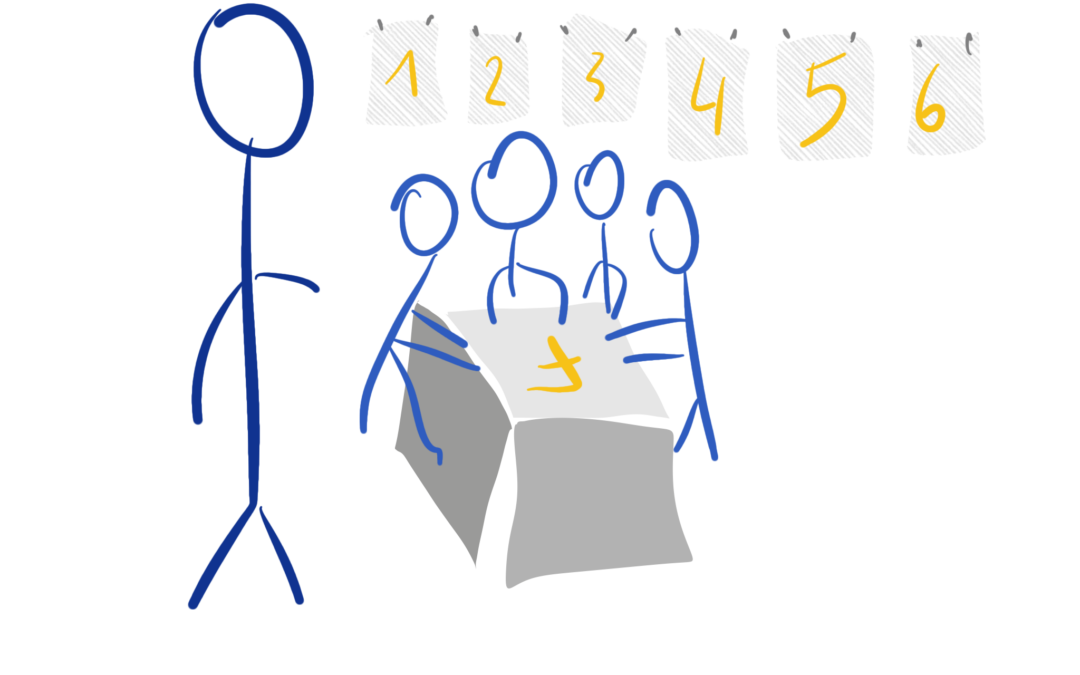100 Teaching Methods, tmo, Uncategorised |
Time needed: 1 – 20 min
Why? Use their natural curiosity.
When? Any time in bilingual or language classes are questions about meanings of terms.
How? If students dont understand the second language (English) don’t always just deliver them translated solutions, let them translate themselves, it is much more effective and supports the proud at their own achieved results. You can force them to translate for each other, or in group work as well in pairs. Use their natural curiosity to find out meaning by self. Provide dictionaries in class. You also can use this method while you continue teaching other students, to let more advanced students find out unclear terms for weaker students.
Any risks? Before you involve the use of dictionaries in class, you have to teach them how to use a dictionary, otherwise it will take too much time to find out the meanings of new terms and those advanced students will miss new introduced knowledge.
100 Teaching Methods, tmo, Uncategorised |
Why? Teaching outside the classroom always breaks the usual rituals and makes teaching interesting and relevant to life.
When? Whenever you can imagine that the subject you are teaching has a very close connection to everyday practical life, even sometimes when you cannot imagine that there is a practical connection, look for it and you will be surprised how much everyday connection you will find.+
How? Just prepare your lesson in a very connective way for an outside environment, find cross-connections outside the classroom. You can also use this method to give students a self-directed task to find things outside the classroom that are related to the subject being taught, and later you can bring it back into the classroom and let them explain the reasons why they chose their items. Visit companies, shopping centres and any other place related to everyday life to teach your topic.
Any risks? There are no mistakes to be made in making connections to everyday life, it is very enjoyable for everyone to find these connections and the self-directed learning effect is also enormous. The only risk is that students get easily disrupted, so be aware of this and structure the field trips cleverly to allow space for disruption and to involve back to the theme leading methodologies.
100 Teaching Methods, tmo, Uncategorised |
Time needed: 20 – 30 min
Why? To work on a fictive CV is supporting the connection between phantasy development with topic connected knowledge, as well teaching students how to make an effective CV for themselves later on.
When? Any time you can imagine to repeat absorbed knowledge in a different unusual format.
How? Give the students the task to develop a CV of a fictive person, as an example in Biology, this person is a Specialist for Oceanology, let them form the CV, starting from Place of birth: near the ocean? etc., hobbies: fishes in an aquarium etc., educational background: high school in a city near the ocean, vocational education as a aquarium caretaker, study of biology, dr. in oceanology, involve all special certifications, etc. Let them after finishing the CV introduce this person imagine the student is that person and let them tell about their reasons why they learned or studied this or that, including background and interests.
Any risks? If your are not clear in your instructions, the students will be confused and probably explaining anything else than topic connected content. So be very clear about the result of that method and what students should achieve with such a format.
100 Teaching Methods, tmo, Uncategorised |
Time needed: 5 -10 min (one lesson involved)
Why? Everyone like to feel special once a while.
When? Any time students have birthday.
How? Install a ritual to praise someone in class at this special day. This method is clear a socialization and classroom management method. Those students could take special roles for that day, helping the teachers, being the leader in any decision for one day, celebrate the lessons in a small party situation. If you are forming this special days and including it in your lesson it is not only for the birthday child enjoyable, also for all other students its a break from normal usual rituals and a refreshment for your class.
Any risks? Don’t let those parties get out of control, its not a party replacing a lesson, its a lesson in party atmosphere.
100 Teaching Methods, tmo, Uncategorised |
Time needed: 5 -10 min (one lesson involved)
Why? Everyone like to feel special once a while.
When? Any time students have birthday.
How? Install a ritual to praise someone in class at this special day. This method is clear a socialization and classroom management method. Those students could take special roles for that day, helping the teachers, being the leader in any decision for one day, celebrate the lessons in a small party situation. If you are forming this special days and including it in your lesson it is not only for the birthday child enjoyable, also for all other students its a break from normal usual rituals and a refreshment for your class.
Any risks? Don’t let those parties get out of control, its not a party replacing a lesson, its a lesson in party atmosphere.
100 Teaching Methods, tmo, Uncategorised |
Time needed: 2 – 5 min
Why? A healthy laughter is the secret of a happy life.
When? Any time you get the chance to laugh in your class – do it.
How? Did you every recognized that jokes are a clever conclusion out of reflection of the daily life. We are proclaiming daily life connected teaching – so cleaver jokes are the basis of our lessons. Allow students and yourself to absorb and live funny situations. Allow students and yourself to tell spontaneously jokes in class. Laugh about yourself, this is teaching students to handle own weak moments humorously. Go one step forward and let students create topic connected jokes, you will be surprised how much knowledge you need to create such jokes and how much skills students developed already in that field. Hahahahahahahaha
Any risks? Laugh as often you can it is taking pressure out of hard learning situations and the process of laughing refreshes the brain by taking an enormously amount of fresh air inside your lounges in a very short moment. The only role you should install in that case is laughing about yourself its a quality, but laughing on the expense of others is a bad character trait.
100 Teaching Methods, tmo, Uncategorised |
Time needed: 10 – 30 min
Why? Modern latest technical devices are the future of the daily life, as sooner students get in contact with those instruments as easier, more comfortable and confident they will be in their usage.
When? Any time when a topic is introduced or completed.
How? Let students make topic connected photos with their mobile cameras and send it to their friends, the effect is that this friends will ask what those pictures are about, than the students will have to explain by themselves to their friends like a teacher. You can also form a competition which photo reflects as best the taught topic.
Any risks? There is no risk, it is a very enjoyable method for students and teachers to control and use absorbed knowledge.
100 Teaching Methods, tmo, Uncategorised |
Time needed: 5 – 10 min
Why? Its a method to force self-responsible thinking about topics.
When? Special before introducing a topic you can ask students to bring something connected to the new topic to school, so they will be curious and you can already understand what students know about the new topic already.
How? Ask students to bring an item from home connected to a special topic and tell them to prepare reasons why they choose this item, in some cases you can also give them the task to search for background or functional explanations.
Any risks? There is nearly no risk, students love to show things from their private environments and the method connects the theoretic knowledge with very practical life experiences of the students.
100 Teaching Methods, tmo, Uncategorised |
Time needed: 10 – 30 min
Why? This method is supporting self-responsible reflection of own already absorbed skills and a good control for teachers of gained knowledge.
When? Any time when a topic duration is completed as well as examination and test preparation.
How? Give students one or several questions or discussable sentences they have to reflect about. You can give this task as a lesson exercise or also as a test, but please dont just use it as testing method, it is for students also very enjoyable to just write their own opinion about taught topics from their own perspective, if you always use this method just for your own control of the absorption process in class, students will loose their interest for such an enjoyable task. Give students the task to answer a huge topic very compact and short noted. This is the method, to think bigger and write understandable short notes.
Any risks? Not every student is able to reflect absorbed knowledge in a way of such a summery, if you know students with abilities of writing those summaries in essay format, support them and force them to shorter the essay after that as much as they can. If you find students in your classroom which like to answer questions in short sentences or short comments, give them also the chance to do that, but always think the method is to think about the whole taught subjects in a very compact format. Every student is actually using this method for themselves to prepare tests and examinations with cheat-sheets, that’s exact this method. And because every student knows how to do it, why not using it in class as an absorption and control instrument. Teach them how to make a very effective cheat-sheet as a learning instrument, the only risk is that they will use it in the examination, but also with that – don’t be afraid, if students prepared a real effective cheat-sheet they know what is this short note about, no-one else than the creator of a cheat-sheet can understand it, because this person absorbed the knowledge already with creating the sheet.
100 Teaching Methods, tmo, Uncategorised |
Time needed: 5 – 20 min
Why? Modern latest technology is the future of the daily life. As sooner students get to know those things as easier it is for them to find effective orientation in those devices.
When? You can involve this any time in your lesson, for new researches, to lay fundamental basics for absorbed knowledge, provide interdisciplinary problem solutions etc.
How? If you start to work on a new topic, students love to search in the internet by self already in advance, use this chance and guide them to find out by self, in case of providing fundamental additional information, let them search by their own, its an ideal method to teach them self responsibility and force curiosity.
Any risks? There is no risk every student love to search in the internet because its nearly border-less entertaining and endless full of new knowledge from many different perspectives. Just one risk is that students get lost in the diversity of the internet, so they need a clear guidance and clear roles and structured research requirements. Don’t underestimate students with thinking they will misuse those time for private fun, this is also a part of understanding how to research, guide them correctly with clear specifications and than private fun plus educational needs are meeting in a productive very effective way.
100 Teaching Methods, tmo, Uncategorised |
Time needed: 5 – 20 min
Why? Modern latest technology is the future of the daily life. As sooner students get to know those things as easier it is for them to find effective orientation in those devices.
When? You can involve this any time in your lesson, for new researches, to lay fundamental basics for absorbed knowledge, provide interdisciplinary problem solutions etc.
How? If you start to work on a new topic, students love to search in the internet by self already in advance, use this chance and guide them to find out by self, in case of providing fundamental additional information, let them search by their own, its an ideal method to teach them self responsibility and force curiosity.
Any risks? There is no risk every student love to search in the internet because its nearly border-less entertaining and endless full of new knowledge from many different perspectives. Just one risk is that students get lost in the diversity of the internet, so they need a clear guidance and clear roles and structured research requirements. Don’t underestimate students with thinking they will misuse those time for private fun, this is also a part of understanding how to research, guide them correctly with clear specifications and than private fun plus educational needs are meeting in a productive very effective way.
100 Teaching Methods, tmo, Uncategorised |
Time needed: 10-15 min
Why? Students will be forced to think about a theoretic knowledge in a different way. Special visual and kinesthetic learners will be supported by this method.
When? Any time when the topic is introduced or special periods of interconnection are necessary.
How? Just give the students the task to draw a cartoon or comic or simply a painting including the taught knowledge.
Any risks? There is no risk just advantages, every child likes to draw and to produce and use absorbed knowledge in different unconventional ways. Just try it!
100 Teaching Methods, tmo, Uncategorised |
Time needed: 1 to 15 min.
Why? Singing is an emotional act. It creates bonding and a common ground for all activities. Singing comforts and singing is fun. Fun is better for learning.
When? Any time you feel like it’s time for a change in method. Try to have some songs in your repertoire, for different kind of age groups.
How? There are two possibilities. Either your students know the song already, then go ahead. Find a reason to sing a song – it could be any reason, even „just for fun“ or to start with a common activity. If your students don’t know the song, don’t be afraid to teach them. Line by line. You could write down the text to the whiteboard. Third possibility, it’s a song your students know and you don’t know. In this case: switch roles. Ask a student to become teacher and you will learn the song.
Any risks? If it’s only you who sings it’s not an act happening together. So choose a song which is adequate for your target group. Short and fun – long and fast, there are hundreds of songs out there.
100 Teaching Methods, tmo, Uncategorised |
Time needed: 10 to 30 min
Why? Newspaper and magazines provide up-to date information on current affairs. Articles used for learning link information of schoolbooks (past knowledge) to the present.
When? Whenever you read something you seem to be suitable for being read by your students, save it for later! This could be because of content or because of style.
How? Articles can be photocopied and made available for every student or articles can be read aloud by the teacher. You could also let students read the newspaper aloud – maybe one paragraph each student. Build follow up activities on the content, e.g. discussions or explanations.
Any risks? Articles used must be really good articles, either in terms of content or in terms of style. Best would be both. Don’t get stuck in one language only. Use different languages, this would provide an option to link learning content to foreign language teaching.

100 Teaching Methods, tmo, Uncategorised |
Time needed: 45-90 min
Why? Students presenting a topic learn an active way of dealing with content. This is necessary to develop sustainable knowledge.
When? Once in a time or regularily, presentations are possible in most circumstances.
How? Let students form groups and give them time to prepare content assigned by you or by themself. Help them to find out different roles for every member of the group. One is fine with drawing a poster, the other likes to describe a certain situation by telling a story, etc. Dont’t forget to let a group answer questions of their collegues after the presentation and provide feedback.
Any risks? If repeated and groups stay the same it can happen that personal development gets stuck and group presentations become a boring routine. Help your students to develop new skills and change roles within the groups. Make sure topics assigned to the groups are interesting and challenging. We don’t want to bore our students the hell out, neither as class, nor as goups. This is even more important when you want them to become actively involved.




